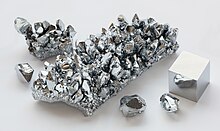 Type: Trace Element
Type: Trace Element
Periodic Element: (Cr)
RDA: 0.05-2 mg
Importance- To Body:
Necessary for glucose metabolism. Essential for proper use of carbohydrates in body; enhances effectiveness of insulin on carbohydrate metabolism; may increase blood levels of HDLs while decreasing levels of LDLs.
Distribution- In Body:
* Approx. % of Body Mass
Widely distributed
Excess Effects:
Industrial exposure may cause Skin Damage and Kidney Damage
Deficiency Effects:
Impaired Ability to Metabolize Glucose
Sources Food:
Meats, Liver, Vegetables, Cheese, Yeast, Brewer’s Yeast, Beer, Wine, Unrefined Wheat Flour, Whole Grains, Corn Oil, Shellfish
Sources Environmental/Geographic:
None listed
Supplemental information:
 |
|||||||||||||||||||||||||||||||||
| General properties | |||||||||||||||||||||||||||||||||
|---|---|---|---|---|---|---|---|---|---|---|---|---|---|---|---|---|---|---|---|---|---|---|---|---|---|---|---|---|---|---|---|---|---|
| Appearance | silvery metallic | ||||||||||||||||||||||||||||||||
| Standard atomic weight (Ar, standard) | 51.9961(6) | ||||||||||||||||||||||||||||||||
| Chromium in the periodic table | |||||||||||||||||||||||||||||||||
|
|||||||||||||||||||||||||||||||||
| Atomic number (Z) | 24 | ||||||||||||||||||||||||||||||||
| Group | group 6 | ||||||||||||||||||||||||||||||||
| Period | period 4 | ||||||||||||||||||||||||||||||||
| Element category | transition metal | ||||||||||||||||||||||||||||||||
| Block | d-block | ||||||||||||||||||||||||||||||||
| Electron configuration | [Ar] 3d5 4s1 | ||||||||||||||||||||||||||||||||
|
Electrons per shell
|
2, 8, 13, 1 | ||||||||||||||||||||||||||||||||
| Physical properties | |||||||||||||||||||||||||||||||||
| Phase at STP | solid | ||||||||||||||||||||||||||||||||
| Melting point | 2180 K (1907 °C, 3465 °F) | ||||||||||||||||||||||||||||||||
| Boiling point | 2944 K (2671 °C, 4840 °F) | ||||||||||||||||||||||||||||||||
| Density (near r.t.) | 7.19 g/cm3 | ||||||||||||||||||||||||||||||||
| when liquid (at m.p.) | 6.3 g/cm3 | ||||||||||||||||||||||||||||||||
| Heat of fusion | 21.0 kJ/mol | ||||||||||||||||||||||||||||||||
| Heat of vaporization | 347 kJ/mol | ||||||||||||||||||||||||||||||||
| Molar heat capacity | 23.35 J/(mol·K) | ||||||||||||||||||||||||||||||||
Vapor pressure
|
|||||||||||||||||||||||||||||||||
| Atomic properties | |||||||||||||||||||||||||||||||||
| Oxidation states | 6, 5, 4, 3, 2, 1, −1, −2, −4 |
||||||||||||||||||||||||||||||||
| Electronegativity | Pauling scale: 1.66 | ||||||||||||||||||||||||||||||||
| Ionization energies |
|
||||||||||||||||||||||||||||||||
| Atomic radius | empirical: 128 pm | ||||||||||||||||||||||||||||||||
| Covalent radius | 139±5 pm | ||||||||||||||||||||||||||||||||
|
|||||||||||||||||||||||||||||||||
| Miscellanea | |||||||||||||||||||||||||||||||||
| Crystal structure | body-centered cubic (bcc) | ||||||||||||||||||||||||||||||||
| Speed of sound thin rod | 5940 m/s (at 20 °C) | ||||||||||||||||||||||||||||||||
| Thermal expansion | 4.9 µm/(m·K) (at 25 °C) | ||||||||||||||||||||||||||||||||
| Thermal conductivity | 93.9 W/(m·K) | ||||||||||||||||||||||||||||||||
| Electrical resistivity | 125 nΩ·m (at 20 °C) | ||||||||||||||||||||||||||||||||
| Magnetic ordering | antiferromagnetic (rather: SDW) | ||||||||||||||||||||||||||||||||
| Magnetic susceptibility | +280.0·10−6 cm3/mol (273 K) | ||||||||||||||||||||||||||||||||
| Young's modulus | 279 GPa | ||||||||||||||||||||||||||||||||
| Shear modulus | 115 GPa | ||||||||||||||||||||||||||||||||
| Bulk modulus | 160 GPa | ||||||||||||||||||||||||||||||||
| Poisson ratio | 0.21 | ||||||||||||||||||||||||||||||||
| Mohs hardness | 8.5 | ||||||||||||||||||||||||||||||||
| Vickers hardness | 1060 MPa | ||||||||||||||||||||||||||||||||
| Brinell hardness | 687–6500 MPa | ||||||||||||||||||||||||||||||||
| CAS Number | 7440-47-3 | ||||||||||||||||||||||||||||||||
| History | |||||||||||||||||||||||||||||||||
| Discovery and first isolation | Louis Nicolas Vauquelin (1797, 1798) | ||||||||||||||||||||||||||||||||
| Main isotopes of chromium | |||||||||||||||||||||||||||||||||
|
|||||||||||||||||||||||||||||||||
Chromium is a chemical element with symbol Cr and atomic number 24. It is the first element in group 6. It is a steely-grey, lustrous, hard and brittle metal which takes a high polish, resists tarnishing, and has a high melting point. The name of the element is derived from the Greek word χρῶμα, chrōma, meaning color, because many chromium compounds are intensely colored.
Ferrochromium alloy is commercially produced from chromite by silicothermic or aluminothermic reactions and chromium metal by roasting and leaching processes followed by reduction with carbon and then aluminium. Chromium metal is of high value for its high corrosion resistance and hardness. A major development in steel production was the discovery that steel could be made highly resistant to corrosion and discoloration by adding metallic chromium to form stainless steel. Stainless steel and chrome plating (electroplating with chromium) together comprise 85% of the commercial use.
Trivalent chromium (Cr(III)) ion was considered an essential nutrient in trace amounts in humans for insulin, sugar and lipid metabolism. However in 2014, the European Food Safety Authority concluded that lacking evidence of benefits, setting any Adequate Intake is inappropriate.
While chromium metal and Cr(III) ions are not considered toxic, hexavalent chromium (Cr(VI)) is toxic and carcinogenic. Abandoned chromium production sites often require environmental cleanup.



